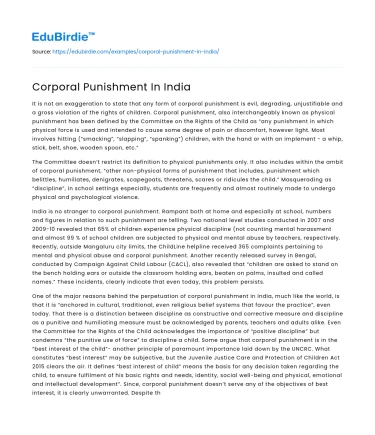It is not an exaggeration to state that any form of corporal punishment is evil, degrading, unjustifiable and a gross violation of the rights of children. Corporal punishment, also interchangeably known as physical punishment has been defined by the Committee on the Rights of the Child as “any punishment in which physical force is used and intended to cause some degree of pain or discomfort, however light. Most involves hitting (“smacking”, “slapping”, “spanking”) children, with the hand or with an implement - a whip, stick, belt, shoe, wooden spoon, etc.”
The Committee doesn’t restrict its definition to physical punishments only. It also includes within the ambit of corporal punishment, “other non-physical forms of punishment that includes, punishment which belittles, humiliates, denigrates, scapegoats, threatens, scares or ridicules the child.” Masquerading as “discipline”, in school settings especially, students are frequently and almost routinely made to undergo physical and psychological violence.
Save your time!
We can take care of your essay
- Proper editing and formatting
- Free revision, title page, and bibliography
- Flexible prices and money-back guarantee
India is no stranger to corporal punishment. Rampant both at home and especially at school, numbers and figures in relation to such punishment are telling. Two national level studies conducted in 2007 and 2009-10 revealed that 65% of children experience physical discipline (not counting mental harassment and almost 99 % of school children are subjected to physical and mental abuse by teachers, respectively. Recently, outside Mangaluru city limits, the ChildLine helpline received 365 complaints pertaining to mental and physical abuse and corporal punishment. Another recently released survey in Bengal, conducted by Campaign Against Child Labour (CACL), also revealed that “children are asked to stand on the bench holding ears or outside the classroom holding ears, beaten on palms, insulted and called names.” These incidents, clearly indicate that even today, this problem persists.
One of the major reasons behind the perpetuation of corporal punishment in India, much like the world, is that it is “anchored in cultural, traditional, even religious belief systems that favour the practice”, even today. That there is a distinction between discipline as constructive and corrective measure and discipline as a punitive and humiliating measure must be acknowledged by parents, teachers and adults alike. Even the Committee for the Rights of the Child acknowledges the importance of “positive discipline” but condemns “the punitive use of force” to discipline a child. Some argue that corporal punishment is in the “best interest of the child”- another principle of paramount importance laid down by the UNCRC. What constitutes “best interest” may be subjective, but the Juvenile Justice Care and Protection of Children Act 2015 clears the air. It defines “best interest of child” means the basis for any decision taken regarding the child, to ensure fulfilment of his basic rights and needs, identity, social well-being and physical, emotional and intellectual development”. Since, corporal punishment doesn’t serve any of the objectives of best interest, it is clearly unwarranted. Despite the existence of a plethora of research confirming that corporal punishment is ineffective and that “the negative consequences of corporal punishment outweigh any benefits”, the erroneous belief that discipline can be achieved only through infliction of punishment is only indicative of the regressive nature of our society.
While there are numerous policies, enactments and guidelines that prioritize the elimination of corporal punishment in India, the abovementioned figures present a different picture. In order to ban corporal punishment not just in theory, but also in practice, we must clear the misperceptions surrounding it. Public awareness regarding the ill effects of this form of punishment should be disseminated. The fact that inflicting corporal punishment can attract criminal penalty should also be reiterated. Therefore, educating the public, sensitizing teachers in training programmes and informing children of their rights can go a long way in reforming attitudes towards corporal punishment.






 Stuck on your essay?
Stuck on your essay?

